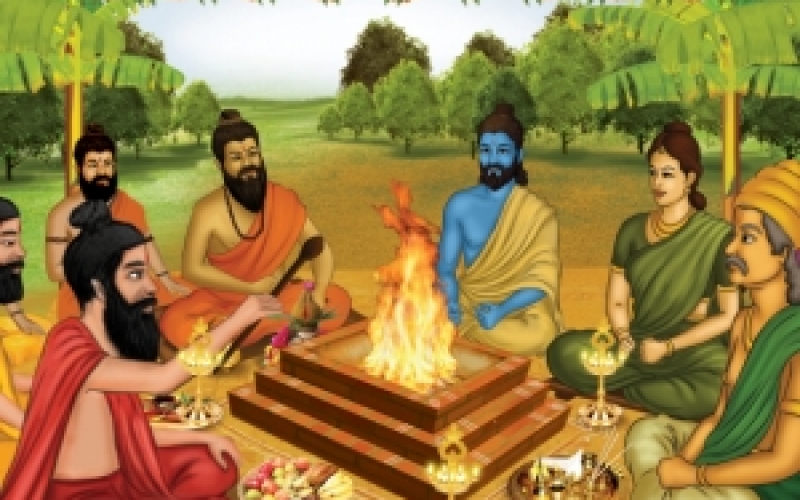Vedangas
By Dr. Korada Subrahmanyam

The mass of knowledge, called Veda, is considered to be eternal, i.e. without beginning or end and was discovered by sages. They contain literature that is useful for human beings in terms of Ethics and Spirituality.
The Vedic literature can chiefly be divided into two parts – the former dealing with rituals that would cause transitory results and the latter which deals with Knowledge that causes freedom from the cycle of birth and death. In order to understand the Indian culture, that is stood on four pillars called Puruṣārthas (the purposes of life), viz. Dharma, Artha (money), Kāma (systematic married life) and Mokṣa (uniting the individual soul with universal soul, whereby the cycle of birth and death is arrested). The term Dharma is untranslatable as it is pregnant with meaning. It can be duty or the right path etc. Veda is described as the text from where Dharma has originated.
Both Artha and Kāma are acceptable if they are associated with Dharma only and it is only Dharma which ultimately leads one to Mokṣa. Most of the people in the world aim at Artha (earning money) and Kāma (sexual enjoyment) both so as they are devoid of Dharma and the results last for a short period of time only.
Another important aspect of Vedic Culture is the Theory of Karma which means one should suffer for his sinister deeds and enjoy for the good ones. The result of Karma (nemesis) cannot be escaped by any person.
Vedāṅgas
The word aṅga (Veda + aṅga = Vedāṅga) means a limb. If Veda is considered as a person then it consists of six limbs called Vedāṅgas, viz. Sikṣā (Phonetics), Vyākaraṇam (Grammar), Chandas (Prosody), Niruktam (Semantics), Jyotiṣam (Astrology) and Kalpa (Practice of Vedic rites).
The above mentioned six systems help one to understand the Vedic literature and have got their origin in Veda itself. In other words, the Vedāṅgas are connected with Veda in a way that is akin to a body and its limbs. Chandas is the two feet of Vedapuruṣa (the person called Veda); Kalpa is the two hands; Jyotiṣam is two eyes; Niruktam is two ears; Sikṣa is nose; and Vyākaraṇam, the mouth. Here is an outline of the Vedāṅgas : –
1. Sikṣā: This is the basic Vedāṅga that explains as to how the letters are born, how to pronounce letters, the time for pronouncing short, long etc. letters, how to read/speak, different accents (useful in Vedic recitation), qualities of good and bad reader and the general mistakes committed by speakers etc.
2. Vyākaraṇam: Literally it means an instrument useful in the separation of Śabdas (perfect words) from Apaśabda (imperfect words). One should attain Dharma even through the use of perfect (analysed by Vyākaraṇam) Śabdas. So, Vyākaraṇam is not simply Grammar, rather it is more than that. In other words, Vyākaraṇam is flavoured with philosophy. Being the most important Vedāṅga it deals with the form of a Śabda right from a Varṇa (phoneme) to a Mahāvākyam (Discourse). It is also considered as a Darśanam (a Philosophical System like Vedānta useful in attaining Mokṣa).
3. Chandas: This Vedāṅga deals with different meters of mantras (hymns etc.) and poems also.
4. Niruktam: It is just like a tail end of Vyākaraṇam and deals with Meaning of Śabdas, compilation of a thesaurus etc.
5. Jyotiṣam: It means the science related to stars and planets. It has got three branches – Muhūrtaskandha (the branch deals with fixing auspicious time for performing Vedic rites), Jātakaskandha (the branch deals with the study of planetary movement and prediction) and Siddhāntaskandha (the branch deals with preparation of an Almanac).
6. Kalpa: The practical part of Vedic rites (kriyā / prayoga – activity) is prescribed by this Vedāṅga. There are four divisions in Kalpa:
1. Śrautasūtram: This deals exhaustively with performance of Yāgas (sacrifices)
2. Gṛhyasūtram: The saṃskāras (ceremonies of purification, such as Vivāha – marriage) are dealt with in this branch.
3. Śulbasūtram: In this branch, the measurements of cottages, altars etc. are prescribed.
4. Dharmasūtram: Different aspects of Vedic Culture, both mundane and spiritual, are discussed in terms of Dharma.
Sūtra means an elliptical sentence, with economy of letters and heavy load of meaning.



